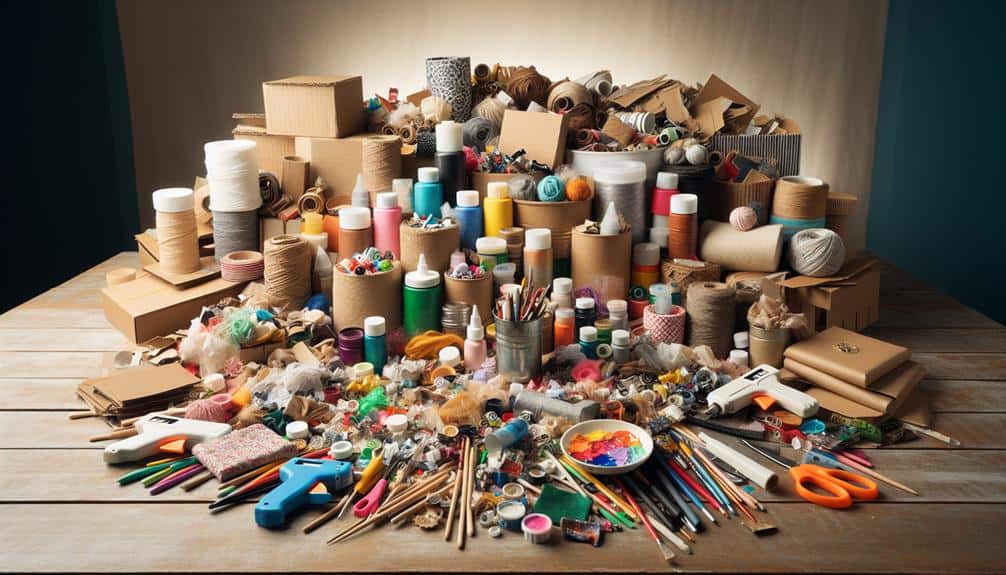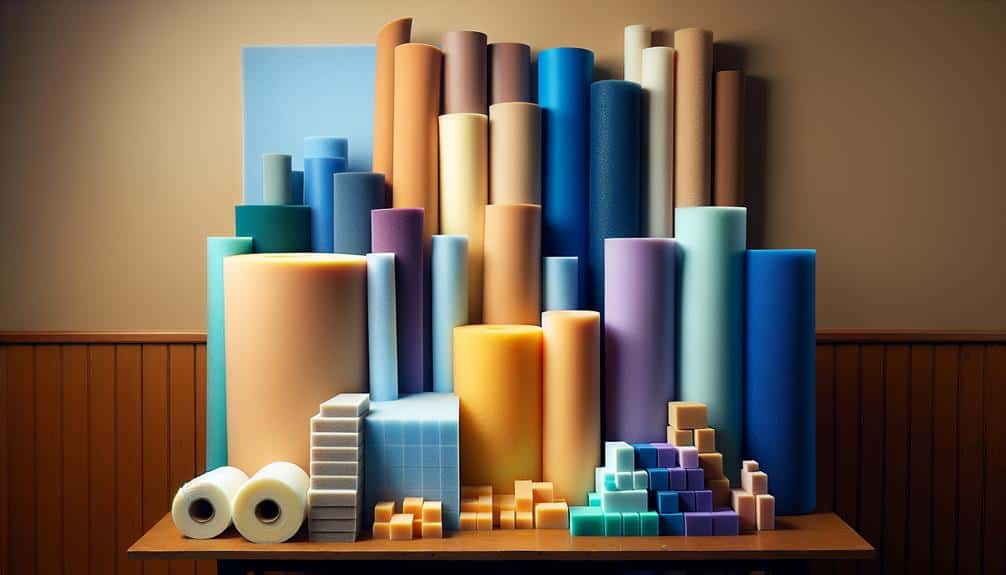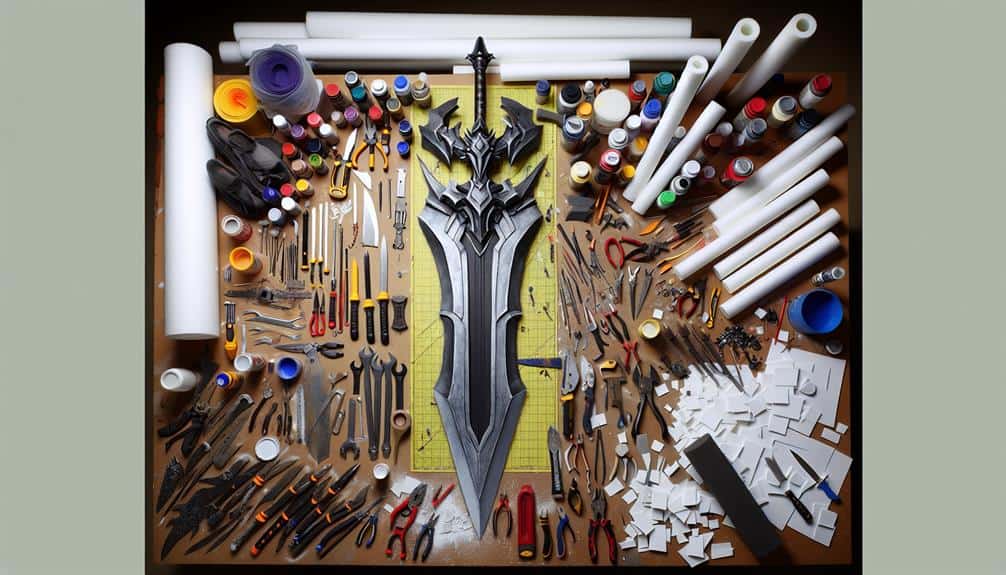When it comes to crafting props on a budget, think outside the box and consider everyday items that can be transformed into show-stopping pieces. From cardboard to PVC pipes, there are several materials that can elevate your DIY prop-making game without breaking the bank.
These cost-effective options not only allow you to release your creativity but also provide a sturdy foundation for your projects. Start exploring the possibilities with these top budget-friendly materials and watch your prop-making skills reach new heights.
Key Takeaways
- Cardboard and PVC pipes are versatile and cost-effective for intricate prop designs.
- Foam and PVC pipes offer lightweight options for customized props and textures.
- Acrylic paint and papier-mâché provide vibrant finishes and smooth textures for props.
- PVC pipes with connectors and acrylic paint with varnish offer professional customization for props.
Cardboard
Explore your creativity with cardboard, a versatile and cost-effective material for crafting stunning props. When it comes to cardboard sculpture, the possibilities are endless. Start by sketching out your design on the cardboard, then carefully cut and layer the pieces to create dimension and form. By bending and shaping the cardboard, you can bring your sculpture to life with curves and angles that add depth and detail.
For cardboard cosplay costumes, cardboard's lightweight yet sturdy nature makes it an ideal choice for creating elaborate and intricate pieces. Begin by creating a basic structure using cardboard as the base, then add layers to build up the costume's shape. With some paint, glue, and a touch of creativity, you can transform cardboard into armor, weapons, or even full suits that rival professionally made costumes.
With cardboard, prop making becomes an affordable and accessible craft that allows you to release your imagination and bring your ideas to life in ways that are only limited by your creativity.
Foam
Crafting with foam opens up a world of possibilities for creating lightweight and versatile props that can easily be shaped and customized to bring your imaginative ideas to life. Foam is a fantastic material for creative sculpting and lightweight construction in prop making.
One popular type of foam used by DIY enthusiasts is EVA foam, known for its flexibility and durability. This foam can be carved, heat-shaped, and sanded to achieve intricate details. Another option is foam board, which is easy to cut and layer for building dimensional props.
Creating texture on foam surfaces is simple with tools like heat guns or hot knives to mold and sculpt the foam into desired shapes. Additionally, foam can be painted with acrylics or coated in various finishes to achieve the desired look for your prop.
PVC Pipes
Explore the world of prop making with PVC pipes, a versatile, cost-effective material that can be transformed into a wide array of props for your creative projects. PVC pipes offer endless possibilities for prop making, and with a few additional materials, you can bring your imagination to life.
- Pipe Insulation: PVC pipes can be easily transformed into swords, staffs, or other weapon props by adding pipe insulation to mimic a realistic grip or blade texture.
- PVC Connectors: Utilize PVC connectors to create elaborate structures such as armor pieces, futuristic gadgets, or even intricate set pieces by joining pipes at various angles and configurations.
- Prop Building Techniques: Experiment with heat-shaping PVC pipes to create curved or twisted shapes for horns, tentacles, or decorative elements on your props.
- Customized Creations: Combine PVC pipes with other materials like foam, fabric, or paint to build customized props such as magic wands, sci-fi blasters, or even elaborate costume accessories.
Acrylic Paint
Awaken your creativity with acrylic paint, a versatile medium that can add vibrant color and texture to your prop making projects. When working with acrylic paint, mastering various paint techniques can truly elevate your props. Experiment with dry brushing to add depth and highlights, or try stippling for a textured effect. These techniques can help you achieve a professional finish on your creations.
Color mixing is another essential skill to master when using acrylic paint. By blending different colors together, you can create custom shades that perfectly suit your prop design. Remember, acrylic paint dries quickly, so work swiftly when mixing colors to achieve the desired hue. Start with primary colors and gradually add small amounts of other colors until you reach the perfect tone.
To enhance the durability of your props, consider sealing them with a clear acrylic varnish once the paint has dried completely. This final step won't only protect your props but also give them a professional look. Experiment with different paint techniques and color mixing to bring your prop making projects to life with acrylic paint.
Papier-Mâché
Immerse yourself in the world of papier-mâché, a versatile and cost-effective material for creating lightweight and durable props. Papier-mâché offers endless possibilities for crafting unique and detailed props.
Here are some tips to help you master the art of papier-mâché:
- Sculpting Techniques: Use a mix of torn paper strips and a paste made of flour and water to sculpt your props. Experiment with different textures and shapes to bring your creative designs to life.
- Creative Designs: Let your imagination soar by building intricate structures and detailed features using papier-mâché. Whether you're crafting masks, armor pieces, or decorative items, papier-mâché can easily adapt to your creative vision.
- Drying Process: Ensure proper ventilation and allow sufficient drying time between layers to prevent mold and maintain the structural integrity of your props.
- Smooth Finishes: Sanding between layers and using a smooth topcoat can help achieve professional-looking finishes on your papier-mâché props. This step is important for adding a polished touch to your creations.
Frequently Asked Questions
Can These Materials Be Easily Recycled or Disposed of After Use?
When making DIY props, it's key to take into account their environmental impact and sustainable disposal. Opt for cost-effective materials that can be recycled through DIY methods, ensuring a creative process that's easy on your wallet and the planet.
Are There Any Potential Safety Hazards or Precautions to Consider When Working With These Materials?
When crafting props, always prioritize safety. Identify potential hazards like sharp edges or toxic fumes. Take necessary precautions such as wearing gloves or working in a well-ventilated area. Prioritize safety over cost.
How Do These Materials Compare in Terms of Durability and Longevity for Prop Making Projects?
When considering durability and longevity for prop making projects, compare materials based on their cost efficiency, environmental impact, and ease of use. Prioritize longevity to guarantee your creations last, saving time and resources in the long run.
Are There Any Specific Tools or Techniques That Work Best With Each Material?
To work effectively with each material, consider the specific tools and techniques that enhance compatibility. Prioritize safety precautions for sustainable prop making. Experiment with painting options for creative effects while ensuring durability. Your mastery in these areas will elevate your prop-making skills.
Can These Materials Be Easily Painted or Decorated to Achieve Different Effects for Props?
Transforming materials into artistic masterpieces is akin to painting a blank canvas. Discover unique painting techniques for customized surface finishes. Incorporate creative embellishment ideas for texture and detail techniques. Let your props tell a story through your artwork.



